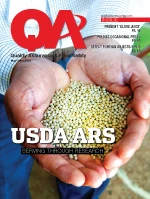 Lisa Lupo Lisa Lupo |
The industry’s relationship with its federal regulatory agencies is a frequently oscillating, controversial one. At the same time that many fight to hold onto the industry’s long-held practice of self-policing, others belittle the agencies’ regulatory practices of non-mandated guidance and voluntary standards. Although leery of the pending enforcement of the Food Safety Modernization Act (FSMA) provisions, most would prefer that the overdue rules be published, so they can work toward compliance rather than operating in a vacuum. The agencies themselves fight an ongoing battle for sufficient resources, not only to enact such legislation for food safety, but to fulfill their mission to work with and respond to the needs of the industry. It is this mission on which we have focused this issue’s cover profile (USDA ARS: Serving Through Research, page 8), and taken the opportunity to tell the other side of the story. While I’ve long known of USDA’s Agricultural Research Service (ARS), it wasn’t until I visited the Beltsville Agricultural Research Center (BARC) in Maryland, that I discovered the extent of this resource—7,000 acres at this center alone; the range of research—more than 100 projects currently in progress at BARC; and the commitment of its people—I met only a small fraction of the 250 scientists and post-doctorates at BARC, but every one I met was not only extremely clever and innovative in their studies, but was open and friendly, enthusiastic about their projects, and excited to discuss their research, findings, and ongoing developments. It is a side of government and its legislative agencies that receives little media attention—or even industry attention. Yet, having celebrated its 100th year in 2010, BARC can boast of extensive industry contributions—from research solutions that extended the shelf life of butter in the 1920s to development of the first computerized near-infrared spectrophotometer in the 1960s and sequencing of the cow genome to predict milk production in dairy cows with three times higher accuracy at one-twentieth the cost in 2010. And it is a side of the story that every industry associate and company that is interested in continued improvement in food safety, quality, or defense should get to know. Not only is ARS conducting its research for the industry, it seeks to work with the industry—welcoming input, requests, and partnerships, and seeking to be called on as a resource. While USDA has authority to mandate its regulation, ARS can only develop solutions and recommendations and make them available to industry; it cannot mandate implementation. As ARS National Program Leader for Food Safety Mary Torrence said, “We can develop methods and techniques, but unless we can transfer our research, our accomplishments are limited.” It is up to each company and person responsible for the quality, safety, or defense of your products to stay updated on all industry research and development and apply it to your products and processes wherever applicable and feasible. The author is Editor of QA magazine. She can be reached at llupo@gie.net. |

Explore the June 2012 Issue
Check out more from this issue and find your next story to read.
Latest from Quality Assurance & Food Safety
- Nestlé Opens Arizona Beverage Factory and Distribution Center
- Ingredion Invests $100 Million in Indianapolis Plant to Improve Efficiency, Enable Texture Solutions Growth
- Eagle Unveils Redesigned Pipeline X-ray System
- USDA Invests Up To $1 Billion to Combat Avian Flu, Reduce Egg Prices
- Washington Cats Confirmed with HPAI as Investigation into Contaminated Pet Food Continues
- USDA Confirms Bird Flu Detected in Rats in Riverside
- Kyle Diamantas Named FDA’s Acting Deputy Commissioner for Human Foods
- QA Exclusive: Food Safety Leaders React to Jim Jones’ Departure, FDA Layoffs





